Page 3 of 727
TABLE OF CONTENTSSECTIONPAGE
1INTRODUCTION .
..............................................................3
2THINGS TO KNOW BEFORE STARTING YOUR VEHICLE
..................................9
3UNDERSTANDING THE FEATURES OF YOUR VEHICLE
.................................131
4UNDERSTANDING YOUR INSTRUMENT PANEL
......................................313
5STARTINGANDOPERATING ....................................................481
6WHATTODOINEMERGENCIES..................................................587
7MAINTAININGYOURVEHICLE...................................................631
8MAINTENANCE SCHEDULES
....................................................685
9IF YOU NEED CONSUMER ASSISTANCE
............................................693
10INDEX .....................................................................703
1
2
3
4
5
6
7
8
9
10
Page 6 of 727
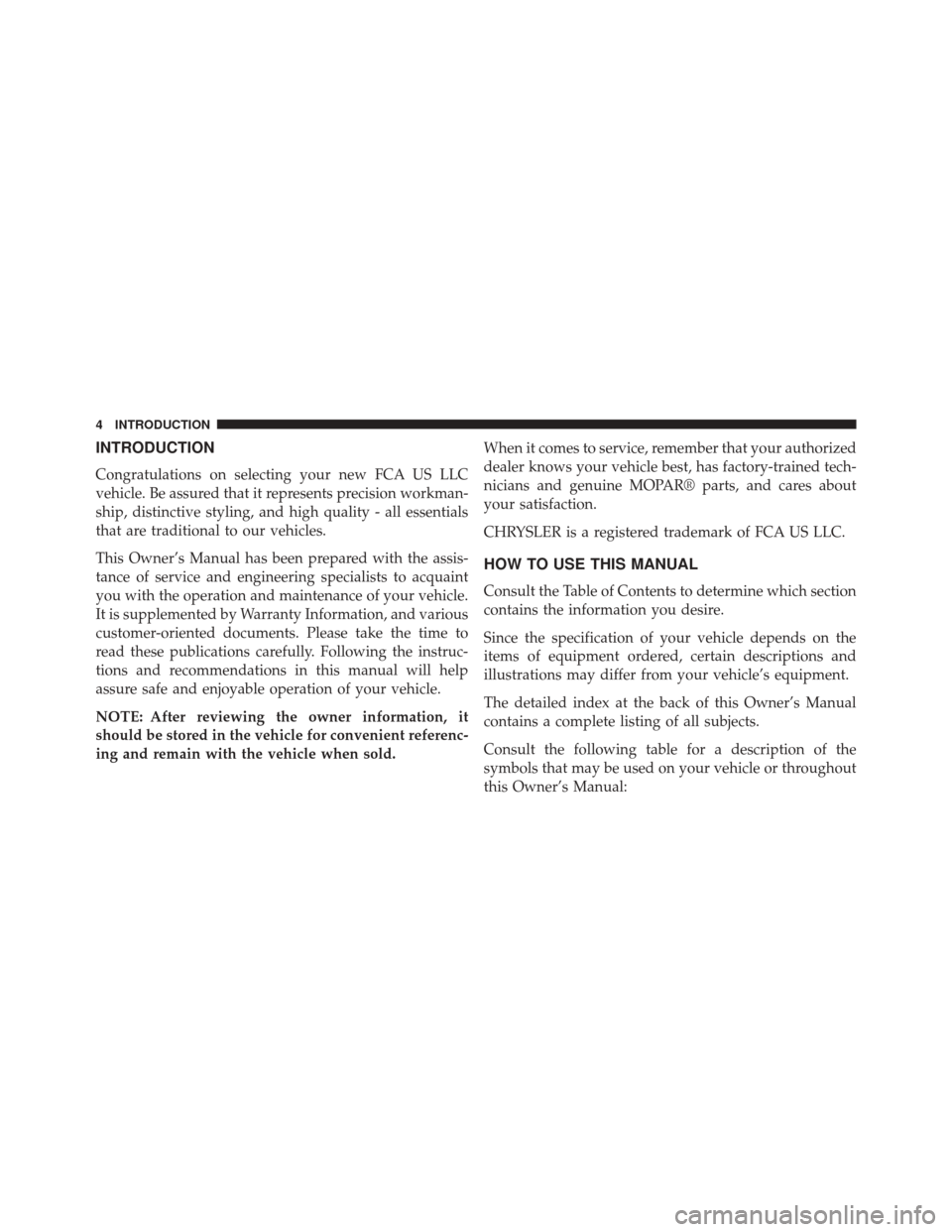
INTRODUCTION
Congratulations on selecting your new FCA US LLC
vehicle. Be assured that it represents precision workman-
ship, distinctive styling, and high quality - all essentials
that are traditional to our vehicles.
This Owner’s Manual has been prepared with the assis-
tance of service and engineering specialists to acquaint
you with the operation and maintenance of your vehicle.
It is supplemented by Warranty Information, and various
customer-oriented documents. Please take the time to
read these publications carefully. Following the instruc-
tions and recommendations in this manual will help
assure safe and enjoyable operation of your vehicle.
NOTE: After reviewing the owner information, it
should be stored in the vehicle for convenient referenc-
ing and remain with the vehicle when sold.When it comes to service, remember that your authorized
dealer knows your vehicle best, has factory-trained tech-
nicians and genuine MOPAR® parts, and cares about
your satisfaction.
CHRYSLER is a registered trademark of FCA US LLC.
HOW TO USE THIS MANUAL
Consult the Table of Contents to determine which section
contains the information you desire.
Since the specification of your vehicle depends on the
items of equipment ordered, certain descriptions and
illustrations may differ from your vehicle’s equipment.
The detailed index at the back of this Owner’s Manual
contains a complete listing of all subjects.
Consult the following table for a description of the
symbols that may be used on your vehicle or throughout
this Owner’s Manual:
4 INTRODUCTION
Page 98 of 727
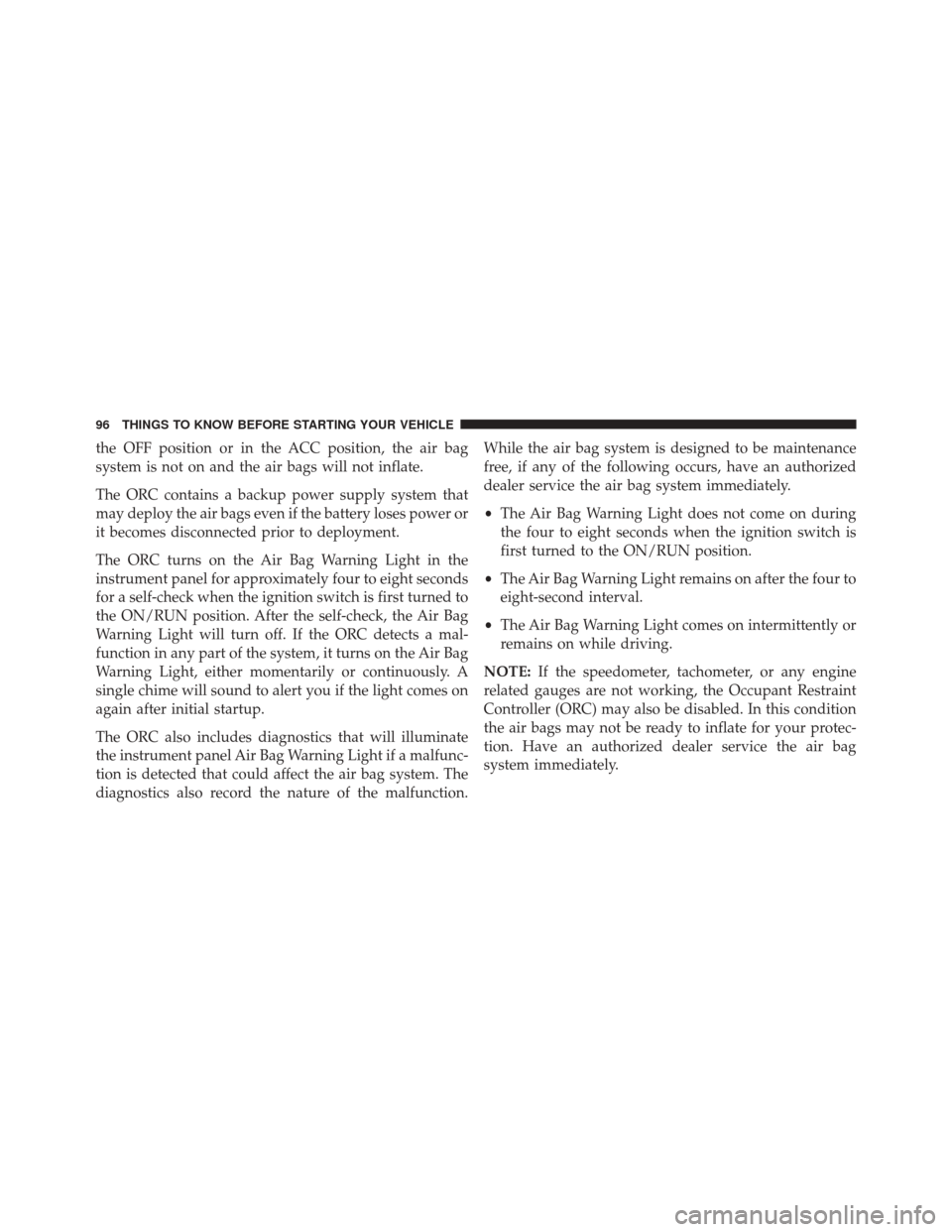
the OFF position or in the ACC position, the air bag
system is not on and the air bags will not inflate.
The ORC contains a backup power supply system that
may deploy the air bags even if the battery loses power or
it becomes disconnected prior to deployment.
The ORC turns on the Air Bag Warning Light in the
instrument panel for approximately four to eight seconds
for a self-check when the ignition switch is first turned to
the ON/RUN position. After the self-check, the Air Bag
Warning Light will turn off. If the ORC detects a mal-
function in any part of the system, it turns on the Air Bag
Warning Light, either momentarily or continuously. A
single chime will sound to alert you if the light comes on
again after initial startup.
The ORC also includes diagnostics that will illuminate
the instrument panel Air Bag Warning Light if a malfunc-
tion is detected that could affect the air bag system. The
diagnostics also record the nature of the malfunction.While the air bag system is designed to be maintenance
free, if any of the following occurs, have an authorized
dealer service the air bag system immediately.
•
The Air Bag Warning Light does not come on during
the four to eight seconds when the ignition switch is
first turned to the ON/RUN position.
• The Air Bag Warning Light remains on after the four to
eight-second interval.
• The Air Bag Warning Light comes on intermittently or
remains on while driving.
NOTE: If the speedometer, tachometer, or any engine
related gauges are not working, the Occupant Restraint
Controller (ORC) may also be disabled. In this condition
the air bags may not be ready to inflate for your protec-
tion. Have an authorized dealer service the air bag
system immediately.
96 THINGS TO KNOW BEFORE STARTING YOUR VEHICLE
Page 126 of 727
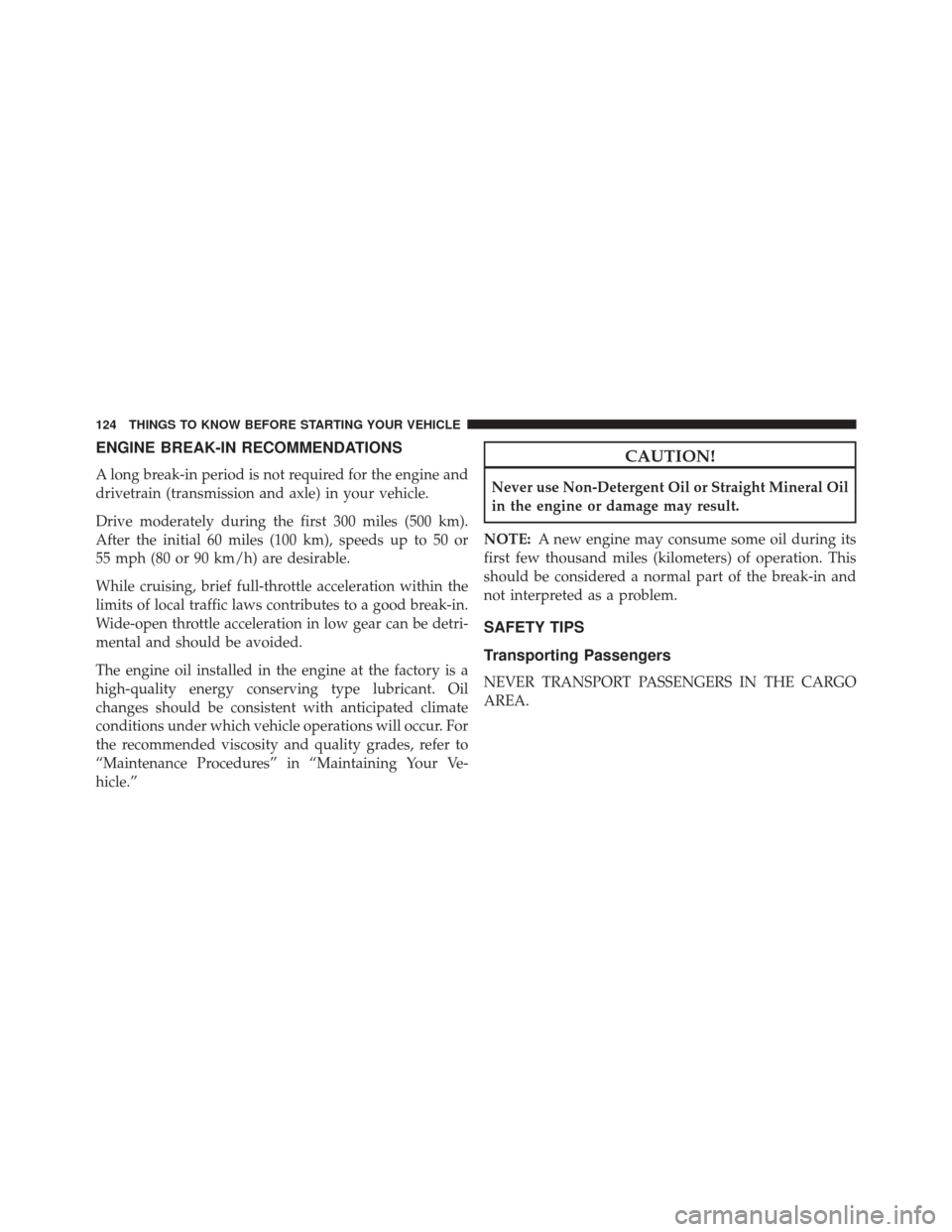
ENGINE BREAK-IN RECOMMENDATIONS
A long break-in period is not required for the engine and
drivetrain (transmission and axle) in your vehicle.
Drive moderately during the first 300 miles (500 km).
After the initial 60 miles (100 km), speeds up to 50 or
55 mph (80 or 90 km/h) are desirable.
While cruising, brief full-throttle acceleration within the
limits of local traffic laws contributes to a good break-in.
Wide-open throttle acceleration in low gear can be detri-
mental and should be avoided.
The engine oil installed in the engine at the factory is a
high-quality energy conserving type lubricant. Oil
changes should be consistent with anticipated climate
conditions under which vehicle operations will occur. For
the recommended viscosity and quality grades, refer to
“Maintenance Procedures” in “Maintaining Your Ve-
hicle.”
CAUTION!
Never use Non-Detergent Oil or Straight Mineral Oil
in the engine or damage may result.
NOTE: A new engine may consume some oil during its
first few thousand miles (kilometers) of operation. This
should be considered a normal part of the break-in and
not interpreted as a problem.
SAFETY TIPS
Transporting Passengers
NEVER TRANSPORT PASSENGERS IN THE CARGO
AREA.
124 THINGS TO KNOW BEFORE STARTING YOUR VEHICLE
Page 137 of 727
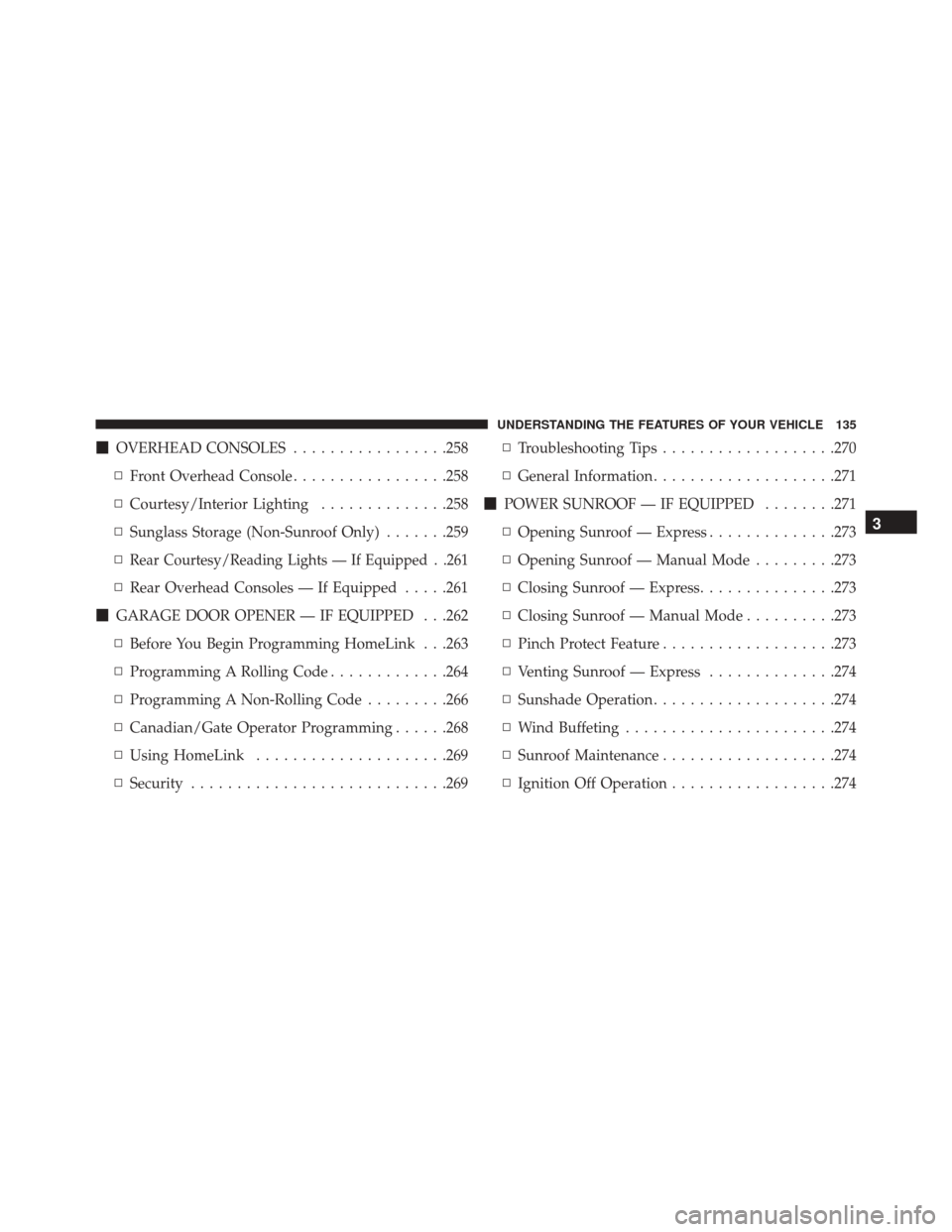
�OVERHEAD CONSOLES .................258
▫ Front Overhead Console .................258
▫ Courtesy/Interior Lighting ..............258
▫ Sunglass Storage (Non-Sunroof Only) .......259
▫
Rear Courtesy/Reading Lights — If Equipped . .261
▫ Rear Overhead Consoles — If Equipped .....261
� GARAGE DOOR OPENER — IF EQUIPPED . . .262
▫ Before You Begin Programming HomeLink . . .263
▫ Programming A Rolling Code .............264
▫ Programming A Non-Rolling Code .........266
▫ Canadian/Gate Operator Programming ......268
▫ Using HomeLink .....................269
▫ Security ........................... .269▫
Troubleshooting Tips ...................270
▫ General Information ....................271
� POWER SUNROOF — IF EQUIPPED ........271
▫ Opening Sunroof — Express ..............273
▫ Opening Sunroof — Manual Mode .........273
▫ Closing Sunroof — Express ...............273
▫ Closing Sunroof — Manual Mode ..........273
▫ Pinch Protect Feature ...................273
▫ Venting Sunroof — Express ..............274
▫ Sunshade Operation ....................274
▫ Wind Buffeting ...................... .274
▫ Sunroof Maintenance ...................274
▫ Ignition Off Operation ..................274
3
UNDERSTANDING THE FEATURES OF YOUR VEHICLE 135
Page 281 of 727
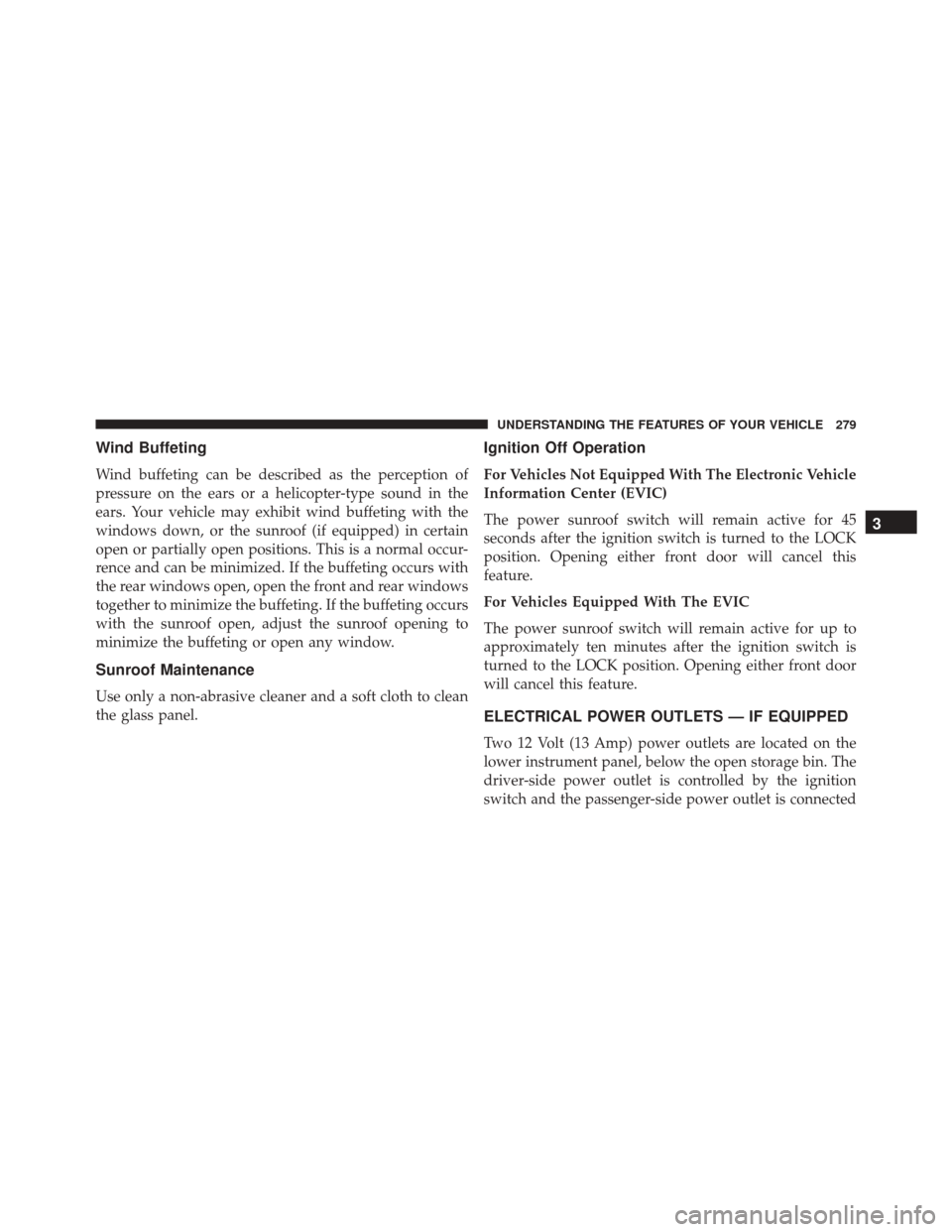
Wind Buffeting
Wind buffeting can be described as the perception of
pressure on the ears or a helicopter-type sound in the
ears. Your vehicle may exhibit wind buffeting with the
windows down, or the sunroof (if equipped) in certain
open or partially open positions. This is a normal occur-
rence and can be minimized. If the buffeting occurs with
the rear windows open, open the front and rear windows
together to minimize the buffeting. If the buffeting occurs
with the sunroof open, adjust the sunroof opening to
minimize the buffeting or open any window.
Sunroof Maintenance
Use only a non-abrasive cleaner and a soft cloth to clean
the glass panel.
Ignition Off Operation
For Vehicles Not Equipped With The Electronic Vehicle
Information Center (EVIC)
The power sunroof switch will remain active for 45
seconds after the ignition switch is turned to the LOCK
position. Opening either front door will cancel this
feature.
For Vehicles Equipped With The EVIC
The power sunroof switch will remain active for up to
approximately ten minutes after the ignition switch is
turned to the LOCK position. Opening either front door
will cancel this feature.
ELECTRICAL POWER OUTLETS — IF EQUIPPED
Two 12 Volt (13 Amp) power outlets are located on the
lower instrument panel, below the open storage bin. The
driver-side power outlet is controlled by the ignition
switch and the passenger-side power outlet is connected
3
UNDERSTANDING THE FEATURES OF YOUR VEHICLE 279
Page 319 of 727
�CD/DVD/Blu-ray Disc MAINTENANCE .....455
� RADIO OPERATION AND MOBILE PHONES . .456
▫ General Information ...................456
� CLIMATE CONTROLS ...................456 ▫
Manual Heating And Air Conditioning System —
If Equipped ........................ .456
▫
Rear Manual Climate Control — If Equipped . .462
▫ Automatic Temperature Control (ATC) — If
Equipped .......................... .464
▫ Operating Tips ...................... .475
4
UNDERSTANDING YOUR INSTRUMENT PANEL 317
Page 324 of 727

CHAngE OIL
Your vehicle is equipped with an engine oil change
indicator system. The odometer display will toggle be-
tweenCHAngE andOilfor approximately 12 seconds,
after a single chime has sounded, to indicate the next
scheduled oil change interval. The engine oil change
indicator system is duty cycle-based, which means the
engine oil change interval may fluctuate dependent upon
your personal driving style.
Unless reset, this message will continue to display each
time you turn the ignition switch to the ON/RUN
position. To reset the oil change indicator system (after
performing the scheduled maintenance), perform the
following steps.
1. Turn the ignition switch to the ON/RUN position (do
not start the engine).
2. Fully push the accelerator pedal, slowly, three times
within 10 seconds. 3. Turn the ignition switch to the OFF position.
NOTE:
If the indicator message illuminates when you
start the engine, the oil change indicator system did not
reset. If necessary, repeat these steps.
Electronic Vehicle Information Center (EVIC) — If
Equipped
The Electronic Vehicle Information Center (EVIC) fea-
tures a driver-interactive display that is located in the
instrument cluster. Refer to “Electronic Vehicle Informa-
tion Center (EVIC)” in this section for further informa-
tion.
3. Speedometer
•Indicates vehicle speed.
4. Fuel Gauge •The pointer shows the level of fuel in the fuel tank
when the ignition switch is in the ON/RUN position
322 UNDERSTANDING YOUR INSTRUMENT PANEL